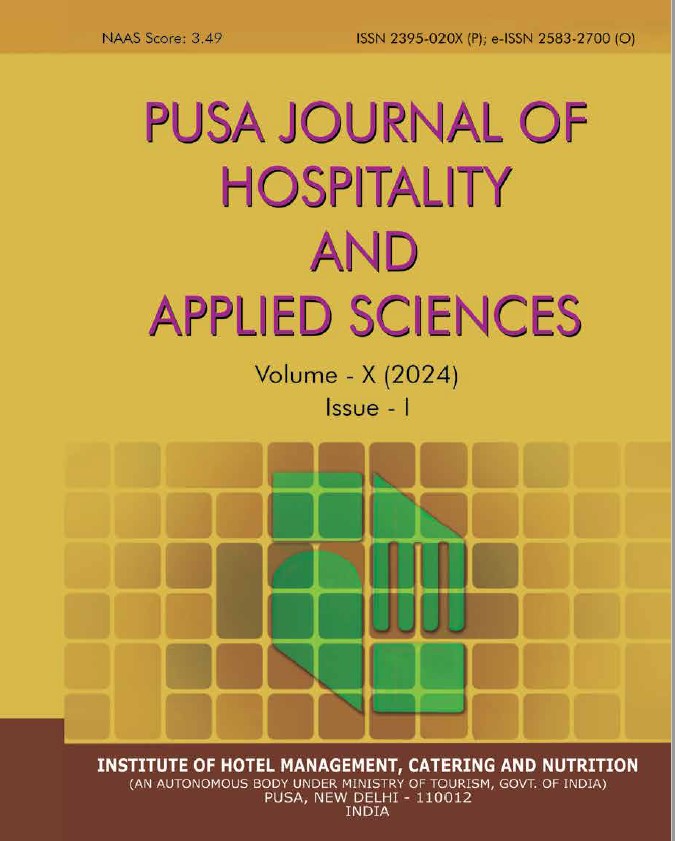Food Safety And Hygiene Standards In The Hospitality Industry
Keywords:
Food Safety, Hygiene, HACCP, Fast Food, Contamination, FSSAIAbstract
Background: With rapid technological changes in the field of food safety, we are moving away from traditional means of cooking and preservation to highly advanced mechanisms and procedures like Sous Vide, High Temperature Short Timing, Irradiation Techniques etc. These changes also bring growth of hospitality industries such as international and national tourism, restaurants, fast-food outlets and catering businesses. Objective: To gain knowledge about the preferences of the customers about food and its safety and secondly to examine the current status of Food and Hygiene standards in popular Quick Service Restaurants (QSRs). Methodology: The whole research has been conducted by surveying the opinions of 50 customers regarding their food habits, preferences, awareness about food safety laws. Fast food from popular fast food QSRs were tested for contamination. Results: The research revealed that while 53% of the respondents checked the hygiene of the outlet they ate in, yet 67% were unaware of the food safety laws in the country. The food samples had negligible contamination except for sample A that had 15 CFU/10ml. Conclusion: The research concluded that the consumers need to be made aware and they also need to have some technical information related to the said subject.
References
Abdussalam, M., & Kaferstein, F. (1999). Food safety in the 21st century. Bull World Health Organ, 77(1), 347-351. Retrieved from https://www.ncbi.nlm.nih.gov/pmc/articles/ PMC2557642/.
Adams, M., Dean, M., Egan, M., Eves, Grubb, S., Lumbers, M., & Raats, M. (2007). A review of food safety and food hygiene training studies in the commercial sector. Food Control, 18(10), 1180-1190. doi:10.1016/j.foodcont.2006.08.001
Arora, S., (2015). Food Regulations—What is the Current Scenario in India? Retrieved February from http://www.foodqualityandsafety.com/article/food-regulations-what-is-the current-scenario-in-india-2/?singlepage=1
Athukorala, P., & Jayasuriya, S. (2003). Food Safety Issues, Trade and WTO Rules: A Developing Country Perspective. The World Economy, 26(9), 1395-1416. doi:10.1046/ j.1467-9701.2003.00576.x
Baroudi, K., Kassa, H., & Silverman, G.S., (2010). Effect of a Manager Training and Certification Program on Food Safety and Hygiene in Food Service Operations. Environmental Health Insights, 4. doi:10.4137/ehi.s4717
Beck, A.J., & Ropkins, K. (2000). Evaluation of worldwide approaches to the use of HACCP to control food safety. Trends in Food Science & Technology, 11(1), 10-21. doi:10.1016/ s0924-2244(00)00036-4
Bredahl, M.E., Caswell, J.A., & Hooker, N.H. (1998). How Quality Management Metasystems Are Affecting the Food Industry. Applied Economic Perspectives and Policy, 20(2), 547-557. doi:10.2307/1350007
Bhushan, C., Khurana, A., & Tewari, A. (2017). Double Standards, Antibiotic Misuse by Fast Food Companies, Centre for Science and Environment, New Delhi. https://cdn. cseindia.org/.../double-standards-antibiotic-misuse-by-fast-food- companies....
Cartwright, R. (2003). Food and waterborne infections associated with package holidays. Journal of Applied Microbiology, 94(S1), 12-24. doi:10.1046/j.1365-2672.94.s1.2.x
Clayton, D., Griffith, C., Price, P., & Peters, A. (2002). Food handler’s beliefs and self-reported practices. International Journal of Environmental Health Research, 12(1), 25-39. doi:10.1080/09603120120110031
Corigliano, M.A., & Hjalager, A. (2000). Food for tourists—determinants of an image. International Journal of Tourism Research, 2(4), 281-293. doi:10.1002/1522- 1970(200007/08)2:43.3.co;2-p
Eves, A., & Seaman, P. (2006). The management of food safety—the role of food hygiene training in the UK service sector. International Journal of Hospitality Management, 25(2), 278-296. doi:10.1016/j.ijhm.2005.04.004
Griffith, C.J., & Worsfold, D. (2003). A survey of food hygiene and safety training in the retail and catering industry. Nutrition & Food Science, 33(2), 68-79. doi:10.1108/00346650310466655
Jensen, H.H., & Unnevehr, L.J. (1999). The economic implications of using HACCP as a food safety regulatory standard. Food Policy, 24(6), 625-635. doi:10.1016/s0306-9192(99)00074- 3
Kidd, M. (2000). Food safety- Consumer concerns. Nutrition & Food Science, 30(2), 53-56. doi:10.1108/00346650010314250
Lues, J., & Tonder, I.V. (2007). The occurrence of indicator bacteria on hands and aprons of food handlers in the delicatessen sections of a retail group. Food Control, 18(4), 326-332. doi:10.1016/j.foodcont.2005.10.010
Madhvapaty, H., & Dasgupta, A. (2015). Study of Lifestyle Trends on Changing Food Habits of Indian Consumers. IOSR Journal of Environmental Science, Toxicology and Food Technology (IOSR-JESTFT). 9(1), 16-22 www.iosrjournals.org DOI: 10.9790/2402- 09121622 www.iosrjournals.org. e-ISSN: 2319-2402, p- ISSN: 2319-2399
Okello, J.J., & Swinton, S.M. (2007). Compliance with International Food Safety Standards in Kenyas Green Bean Industry: Comparison of a Small- and a Large-scale Farm Producing for Export. Review of Agricultural Economics, 29(2), 269-285. doi:10.1111/j.1467- 9353.2006.00342.x
Rhodehamel, E.J. (2013). Overview of Biological, Chemical, and Physical Hazards. In HACCP: Principles and Applications: Chapman & Hall, 8-28.
Steffen, R. (1999). Epidemiology, Etiology, and Impact of Travelers Diarrhea in Jamaica. Jama, 281(9), 811. doi:10.1001/jama.281.9.811
Smed, S., & Jensen, J.D. (2005). Food safety information and food demand [Abstract]. British Food Journal, 107(3), 173-186.doi:10.1108/00070700510586498
Trienekens, J., & Zuurbier, P. (2008). Quality and safety standards in the food industry, developments and challenges. International Journal of Production Economics, 113(1), 107- 122. doi:10.1016/j.ijpe.2007.02.050
Yeung, R.M., & Morris, J. (2001). Food safety risk. British Food Journal, 103(3), 170-187. doi:10.1108/00070700110386728




